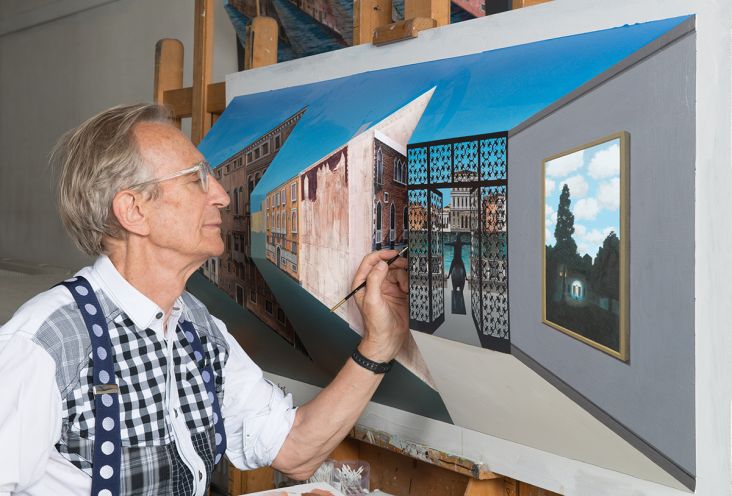All Change: How to ditch the job you hate and shift to a creative career
Do you ever see an advert, poster or logo and think: I’d love to be the person who designed that? Or spot beautiful a photograph on Instagram and wished you'd been behind the camera?

Image licensed via Adobe Stock
There'll be many of you out there, wishing you could change jobs into something like graphic design, illustration or photography. But because of a whole host of reasons, you don't pursue it, worried about finances, existing commitments, time poverty, even being "too old" to make a career change.
But if you’re stuck in a job you loathe rather than love, the fact is that it’s never too late to ditch and switch to that creative career you’ve dreamed about, which could easily be within your reach if you pick the right path.
But before you start writing that resignation letter, it’s essential to prepare. Here’s how to ensure your transition into your creative career is smooth, stress-free and successful:
1. Tackle the important question
If money was no object, what would you rather be doing? Yes, you're likely to dream about lying on a tropical beach and reading a good book, but think beyond the fantasy and consider how you'd like to spend your working days. Forget about all the excuses that have been holding you back – believe anything is possible, and you'll find that the answer comes to you quite easily.
2. Consider your existing skills
Ask yourself: what am I good at? What do I enjoy? Because there's no point in switching careers to something more creative unless you have a good foundation to work with. Write down a list of your skills so that you can see your full potential. Great at drawing? Love playing with your camera? Can't get enough of writing? Whatever it is, make a note of it – so the path before you becomes clear.
3. Work out the best route to success
So you've figured out what you want to do, and that's a fantastic first step towards career nirvana. Now you have to realise it's entirely possible to do it, but that it relies on you – and you alone – to action.
It won't happen overnight. You won't leap out of bed the next day and suddenly be a graphic designer. It will take time and effort, but if you put steps in place – you'll be closer to achieving your dream.
Sit down and work out how you're going to switch careers. Set yourself three achievable goals that will help you get there. This is what I do every New Year's Eve – I lay down three tasks for the next 12 months that will help me to stay focused and achieve my dreams. And let me tell you, I more than surpass my expectations every year.
Don't think you can do it? When a friend of mine told me three years ago that she was stuck in a job she didn't love, and wanted to do something more creative – I told her anything was possible, but she didn't believe me. Not at first.
In her spare time, she loved to take photographs, and she was quite good at it. So I posed the question – why not train to be a photographer? She was stunned at my suggestion and didn't think it was possible. So I told her about my annual 'three goals' and nailed home the message that nothing is going to happen unless she makes it happen.
Leaving that seed planted in her head, I caught up with her several months later – and you know what? She was still working at her job, but during her spare time, she had saved up for a better camera, enrolled on several photography courses, and had offered to do a few friends' weddings for free to build up her portfolio.
That was three years ago; today she is a successful wedding photographer with lots more training under her belt, better camera equipment and a portfolio that makes me so proud. She confessed – once she realised anything was possible, she became incredibly focused and still strives to improve, using my 'annual three goals' trick today.
4. Research courses & campuses
Although you might feel you have a natural talent for your new career, you’ll often need qualifications to get work. As a first step, find out which higher education centres and campuses offer courses in the job you want. Many colleges have adult courses designed especially for people who want to change careers, such as Shillington – which offers nine-month part-time courses on graphic design.
Go to open evenings, take a tour, ask questions. Find out how much time you need to invest in studying, what the costs are and what the end qualification will be – it’s vital to ensure it’s sufficient to get you started in your new career.
Talk to the tutors and past students if you can, for reassurance that you are going to get real, employable skills at the end of it all. Starting on the right course, at the right campus, will help secure the solid foundations of your new career path.
5. Get ‘Real’ learning
It’s one thing to add qualifications to your name; it’s quite another to have a polished portfolio and studio experience to show prospective employers or clients. Learning in a professional environment will give you the experience of what it’s like to work in your dream career.
In which case, if you're keen to get into graphic design or adopt a career in writing – acquire some valuable work experience with local studios or agencies. Or if you're studying, make sure your chosen course is more than just a classroom, knowing how to work in your new career environment will put you above the rest.
If it's photography or illustration that floats your boat, consider offering a discounted rate or even work for free – to build up a portfolio that will lead you to more significant opportunities.
6. Full-time or part-time?
Your circumstances and even financial situation will dictate how much time you can invest in gaining your qualifications and experience. For instance, an intensive full-time course is likely to be a much quicker journey to your qualification than part-time study. But as you’ll be studying instead of earning, you’ll want to build up a savings nest-egg first to see you through.
So plan and put aside any spare cash into a 'study fund'. Even if you opt for part-time study, which is more flexible, it’s still a good idea to have at least six months of outgoings aside, so you’re not worrying about finances when you’re newly-qualified and trying to establish yourself.
7. Endure the initial pain
I'm just getting into cycling. Not mountain biking, you understand — more the Chris Froome type of cycling. And one of the critical rules of this type of endurance sport is *Harden the f**k up!* On my first few rides, I complained a little about neck pain (I've not yet relaxed my upper body) and 'saddle sore' (it is the worst!). My cycling-mad father-in-law and husband (whom I ride out with) told me it's normal and I have to endure it during these initial months.
My point is – nothing comes for free. If you want something, if you're going to improve and progress, you have to endure the pain, and put in the time and effort. To switch careers, that might mean sacrificing a few evenings and weekends. It might mean a drop in earnings. It is likely to involve lots of hard work. Endure the initial pain, and you'll find that you are well on your way to doing something you love.
8. Don’t just dream – do it
So you’re serious about switching jobs – but something always gets in the way? There’s always an excuse to delay taking the plunge, but changing careers was never for the faint-hearted, no matter what stage of life you’re in. It’s time to be brave and make a commitment.
Think about the result – it is possible, with conscious effort and investment, to become a qualified, graphic designer, a successful wedding photographer, a freelance illustrator or a web developer in demand. The only thing that stands in your way is you. Once you've realised this revelation, you'll make anything possible!




 by Tüpokompanii](https://www.creativeboom.com/upload/articles/58/58684538770fb5b428dc1882f7a732f153500153_732.jpg)


 using <a href="https://www.ohnotype.co/fonts/obviously" target="_blank">Obviously</a> by Oh No Type Co., Art Director, Brand & Creative—Spotify](https://www.creativeboom.com/upload/articles/6e/6ed31eddc26fa563f213fc76d6993dab9231ffe4_732.jpg)
















